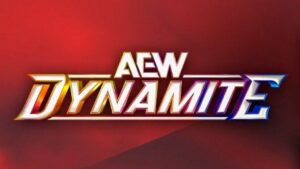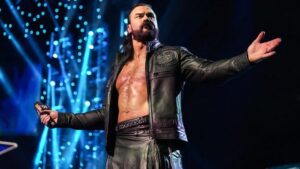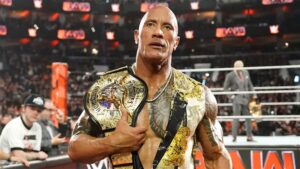Dark Side of the Ring was back on VICE this week, just seven days after the deeply troubling “Plane Ride From Hell” episode aired and caused a stir. Whether you were a fan disgusted by some of the antics which took place, or someone deeply appalled by some of the comments made during the episode, there is no denying that it was an exceptionally poignant episode which brought negative light to the professional wrestling culture of the early 2000s. This week’s episode of Dark Side of the Ring moves on from multi-wrestler plane rides to take a look at the Double Life of Chris Kanyon; a professional wrestler widely dubbed as being one of the most underrated talents of his generation, as well as being one of the first names in the industry to come out as gay. Here are the takeaways from the episode.
“The Double Life of Chris Kanyon” starts now on @vicetv. #DarkSideoftheRing pic.twitter.com/3xcVgErP1z
— Dark Side of the Ring (@DarkSideOfRing) September 24, 2021
Double Life of Chris Kanyon – What We Learned
Background Information
Chris Kanyon, born Christopher Morgan Klucsarits on January 4th, 1970, was a North American professional wrestler hailing from Queens, New York. Kanyon, like many big-time professional wrestlers in the 1990s, appeared for both WCW and the then-WWF (WWE). In that time, he captured numerous titles, most notably the WCW version of the United States Championship and the WCW World Tag Team Championships, alongside friend and partner, Diamond Dallas Page (DDP).
Later in his life, Kanyon would come out and acknowledge he was gay – something which shocked many a fan and wrestler, but not some of his closest friends who either suspected it, found out by circulating rumors or were told by Kanyon personally. DDP, himself, expresses his shock at finding out during the episode. Having struggled with bipolar disorder for much of his adult life (though not being diagnosed until late into his life) , as well as conflicting thoughts on his sexual orientation, Kanyon struggled with depressive aspects of the condition and was found dead on April 2nd, 2010, with a bottle of antidepressants and an apology note written for his family. He remains a beloved pro wrestler, trainer and man; widely deemed as one of the most underappreciated talents of his generation.
Innovator of the “Indie Style”
The episode opens with Kanyon’s best friend, DDP, expressing how wrestling Kanyon was “fun”. Their friendship was strong enough that they would, together, become two-time Tag Team Champions and this friendship was clearly developed during the singles matches they worked with each other. DDP named Kanyon in the top 5% of workers he had been in the ring with.
The Young Bucks (Matt & Nick Jackson) dub Kanyon as being one of the first to work the “independent style” of wrestling. The Young Bucks, though belonging to the next generation of pro wrestler, were good friends with Kanyon, from their time working with him on the independent wrestling circuit. They cite Kanyon’s ability to sell moves and string along offense as being inspirational to wrestlers who grew up watching him.
Early Acknowledgement of Homosexuality
One of Kanyon’s oldest friends was AEW Executive, Rafael Morffi. They grew up together, attending the same schools and parishes – Morffi dubbed him the “King of Sunnyside New York”. In addition to attending the same schools and parishes, they would also work together in the WWE. Morffi mentions that Kanyon’s difficulty in expressing his sexual orientation stemmed from his Catholic upbringing – which led to him viewing his own sexuality as sinful. Kris was told by an authority figure at his school to “not give into Satan or temptation” and this, no doubt, led to decades of conflicting thoughts about his sexuality. However, Morffi did state here that Kanyon acknowledged it was “who he was”.
James Mitchell, known in wrestling as the “Sinister Minister” James Vandenberg, addressed that Kanyon presented himself as a “tough guy, New York Catholic” who was very anti-homosexual. He would become the on-screen manager of Kanyon as well as one of his closest, long-time friends in the industry.
Break Into the Business
James Mitchell got Kanyon into the world of professional wrestling through the Lower East Side Wrestling Gym in Manhattan, after convincing the Fabulous Moolah of Kanyon’s worth. After initial “jobber” appearances for the WWF, he would soon appear in WCW. It was during this time when Mitchell, who at this point was a friend and mentor to Chris, learned of his sexual orientation through an unfortunate event involving pornographic VHS tapes. This would lead to a hostile response from Kanyon to Mitchell, leading to him breaking Mitchell’s car and cutting ties (at least for now). Mitchell described himself as being the “only man who knows your (Kanyon) secret identity”.
It is here where wrestlers such as Chris Jericho, The Young Bucks and Brian Cage – a student of Kanyon’s – acknowledge that Kanyon was fearful of how his sexuality might affect his career. “It wasn’t as accepted back then”, states Jericho, whilst the Bucks acknowledge that if you were gay in the 1990s era of wrestling, you were likely to receive a comedic, hypersexualized gimmick with a purpose of demoting you to the role of comedy character. DDP states that the “great thing about the Mordis character was that he (Kanyon) could hide behind a mask”.
Birth of Kanyon
The formation of the New World Order (NWO) by Hulk Hogan, Kevin Nash and Scott Hall led to the death of the Mordis character. Gimmicky, cartoonish gimmicks were confound to the dustbin and it is here where Chris Klucsarits would become Chris Kanyon. It is mentioned around this point that Eric Bischoff was a fan of Kanyon and this led to Kanyon being chosen to play such a big role in the Ready to Rumble (2000) movie starring David Arquette, who was trained for the movie by Kanyon.
A dramatic increase in fame led to Kanyon longing for a party lifestyle; converting his house into a beach & bar type of 24/7 party mansion. Mitchell mentions how “women were crawling over him, but he completely no-sells it” which led to one telling Mitchell “I think your friend is gay”. Kanyon heard about it, leading to paranoia and his suggestion that Mitchell shoot a pornographic film of him with a woman to show “the boys” that he wasn’t gay. This would lead to yet another violent altercation between Mitchell and Kanyon, though this time, Mitchell would pull a gun – concealed under his pillow – on the much bigger man. A move to the WWE, with DDP, along with the two title reigns which came with it could not prevent Kanyon from falling into a quite severe depressive phase which would consume him for the duration of the remainder of his life.
The Boy George Incident
After well over a year away from the ring, Kanyon returned: coming out of a giant wooden box (gifted by Paul Heyman to The Undertaker) and, dressed as Boy George, he began singing “Do You Really Want to Hurt Me?” to Undertaker. There is a divide of opinion here. Chris Jericho cites that this was “typical WWE bullying tactics” and that someone must have found out something about Kanyon’s sexual orientation to humiliate him. Rafael Morffi says the opposite, that they (WWE creative) would not have Kanyon spend a year training to come back for the sole purpose of getting humiliated. The Young Bucks acknowledge that the beat down from Taker was especially brutal and hard to watch. The WWE would begin dropping him further down the card before letting him go. We will leave it to you, the reader, to decide whether the “Boy George Incident” was designed to humiliate Kanyon.
Chris Kanyon the Trainer
Following his stint in the WWE, Kanyon would become a trainer. It is here where The Young Bucks and Brian Cage recount heart-warming stories of their friendship with Chris. Cage refers to him as a “giving and selfless guy”, whilst DDP says he would “give you the shirt off his back”. Luke Hawx, a friend of Kanyon, has a Mordis tattoo on his arm. In short, Kanyon touched a lot of lives in the wrestling business and is beloved not only by friends, but by those he trained.
Bipolar Disorder and Confidence to Come Out
An event where Kanyon began to hallucinate with visions of aliens and claims of there being a scientology headquarters nearby led to his being tested and diagnosed for bipolar disorder. He would begin treatment for the condition. When Kanyon came out to Hawx, Kanyon pressed him with a question of “do you hate me for it?” to which Hawx flatly denied, as he didn’t see someone being gay as a reason to hate them – let alone as close a friend as Kanyon. Though Brian Cage admits to initially being surprised and a little “bummed out” by the confession, he went away to think about it and through his friendship with Chris, came to become more tolerant and understanding of homosexuality. Mitchell acknowledged that at this point in Kanyon’s career, he wanted to become a role model for younger, gay wrestlers by being an openly gay wrestler himself.
Mitchell explains how heart-broken Kanyon was over Orlando Jordan taking away his thunder by having the WWE machine behind him to promote his status as an openly homosexual professional wrestler. “You can’t patent being gay”, Mitchell told him. Being a gay role model for young wrestlers and fans alike was clearly something Kanyon desperately wanted to be. His hurt at losing that role to Orlando came through in the episode.
Suicidal Thoughts
Kanyon became very suicidal as his career went into decline. Matt Jackson tells the story of when, at just 19 years old, he was dealing with suicidal phone calls from Kanyon – Jackson’s childhood hero – who would threaten harm against himself, whilst telling Matt to “pray for me, kid”. There is also a clip here of John Cena telling Howard Stern that Chris Kanyon “simply wasn’t good enough”. Kanyon would then, himself, appear on the Howard Stern Show and have Ric Flair phone in to tell Kanyon that he is “not good enough right now” and that his “time has come and gone”.
Mitchell then tells a story of how, in early 2010, he saw Kanyon wrestle the worst match of his career – where fans were laughing at him. At the post-show party, however, he was outwardly happy; telling self-depreciating jokes and conversing with a gay fan who was inspired by Kanyon. Things were looking well, until Mitchell notices Kanyon holding his back in agony. He then tells Mitchell that he tried to commit suicide by jumping in front of a car just a few days earlier. One more fiery altercation between the two would lead to a friendly conversation, leading to the two men howling over the “good old days”. It was at this moment where Mitchell felt that Kanyon was actually going to succeed in killing himself. Not long after, he would do just that by overdosing on antidepressants in his childhood home in Sunnyside. Mitchell mentions that if you have a friend who suffers with any kind of mental illness, whether bipolar disorder or schizophrenia, reach out to them and try to understand them.
The National Suicide Prevention Hotline in the United States is: 1-800-273-8255.
More From LWOS Pro Wrestling
Stay tuned to the Last Word on Pro Wrestling for more on this and other stories from around the world of wrestling, as they develop. You can always count on LWOPW to be on top of the major news in the wrestling world, as well as to provide you with analysis, previews, videos, interviews, and editorials on the wrestling world. Catch Dark Side of the Ring on VICE, with new episodes airing each Thursday at 9 PM EST.






